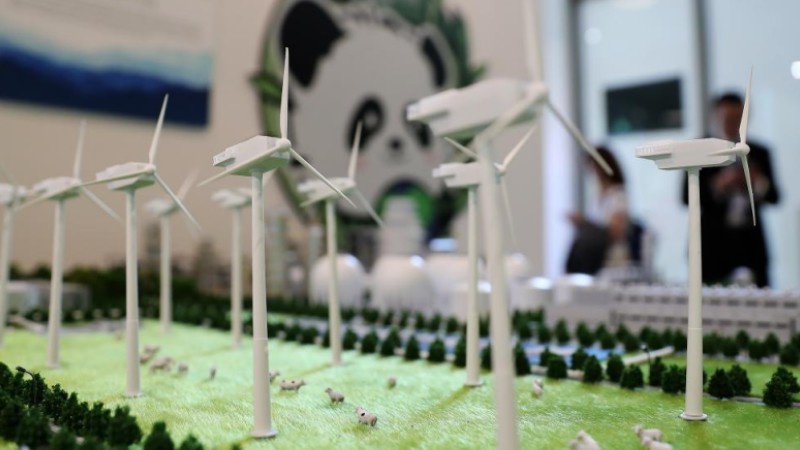With dual carbon goal and its own pace, China moving toward green transition
NANJING, Dec. 7 (Xinhua) -- On a large screen inside Lishui Tianshan Cement Co., Ltd. in Nanjing, the capital of east China's Jiangsu Province, real-time carbon emissions data are displayed to avoid excessive emissions.
"It's a trend for cement enterprises to decarbonize," said Luo Peng, general manager of the company, adding that they collaborated with State Grid Nanjing Power Supply Company to build the cement industry's first comprehensive carbon management project.
"Now more than 95 percent of our carbon emissions can be traced and managed, pushing us to improve production techniques to meet the emission standard dynamically," Luo said.
He noted that the company, with an annual cement output of 1.5 million tonnes and annual carbon dioxide emissions once exceeding 1.2 million tonnes, can now reduce carbon emissions by nearly one million tonnes annually.
While at an international new energy conference held in November in Wuxi, also Jiangsu Province, 73 new energy industry projects were inked, with a total investment of 128.6 billion yuan (about 18.1 billion U.S. dollars).
The decarbonization of the cement plant and new energy investment boom in the economic powerhouse province of Jiangsu is the epitome of how China is continuously moving toward the green transition, as it has committed to dual carbon goals to peak carbon emissions by 2030 and reach carbon neutrality by 2060.
In the past years, China has made enormous efforts to reduce carbon emissions to help tackle global climate change, including upgrading traditional industries, moving up the value chain, and investing heavily in clean energy.
The world's second-largest economy aimed to increase the share of non-fossil energy consumption to around 25 percent by 2030 and lower the CO2 emissions per unit of GDP by over 65 percent in 2030 from the 2005 level.
In 2022, the share of non-fossil energy in China's total energy consumption reached 17.5 percent. The country's carbon emissions intensity decreased more than 51 percent from its 2005 level, according to the 2023 report on China's policies and actions to address climate change.
With excellent progress in developing solar and wind power, electric vehicles, and power batteries, China is a champion of the world in clean energy, said Fatih Birol, Executive Director of the International Energy Agency, at a side event held at the China Pavilion of the COP28 climate change conference.
As a major supplier of wind and solar power equipment and power batteries, China has driven down the cost of renewable energy and helped other countries obtain clean, reliable, and more affordable energy. It provides 50 percent of the world's wind power equipment and 80 percent of global photovoltaic equipment.
China is a leading investor in renewable energy development. By October, its installed renewable energy capacity topped 1.4 billion kilowatts, up 20.8 percent year on year, data from the National Energy Administration showed.
The country is also a global leader in the new energy vehicle (NEV) industry, with NEV sales ranking first globally for the past eight consecutive years.
Between January and October this year, its NEV sales surged 37.8 percent year on year to 7.28 million units, according to the China Association of Automobile Manufacturers.
Earlier this year, the country extended its preferential purchase tax policy for NEVs to the end of 2027. It released a guideline to support people living in rural areas to purchase and use NEVs, focusing on boosting the construction of charging infrastructures.
"At present, every village in Nanjing has charging facilities for NEVs," said Wang Zixuan with State Grid Nanjing Power Supply Company, adding that vehicle owners can find charging points nearby just through their mobile phones.
China has been steadfast in adhering to its dual carbon commitments. However, it has emphasized that the path to achieving its goals and the manner, pace, and intensity of efforts to achieve them should and must be determined by the country rather than swayed by others.
The country would accelerate its planning and construction of a new energy system, improve its industrial structure, and take a more active role in global climate governance.
China has said that the green transition takes time and cannot be achieved overnight, cautioning against campaign-style carbon reductions and "a sudden brake." While lowering carbon emissions, efforts should also be made to ensure security in energy, industrial and supply chains, and food sectors and support people's everyday lives.
China will optimize the path and manner to achieve the dual carbon goals, balance the pace and intensity of the effort, and continuously promote the green and low-carbon transformation of production modes and lifestyles to ensure that the dual carbon goals will be achieved as scheduled, said Zhao Chenxin, deputy chief of the National Development and Reform Commission.
Photos
Related Stories
- Circular economy to contribute over 35 pct of China's carbon reduction by 2030: report
- China releases list of first batch of pilot cities seeking to peak carbon dioxide emissions
- China releases list of first batch of pilot cities seeking to peak carbon dioxide emissions
- Side events and exhibits enable participants to focus on climate-related topics
- Forest fires should be included in carbon emission accounting system: Chinese scientists
- Hangzhou Asian Games achieves carbon neutrality for first time
Copyright © 2023 People's Daily Online. All Rights Reserved.









